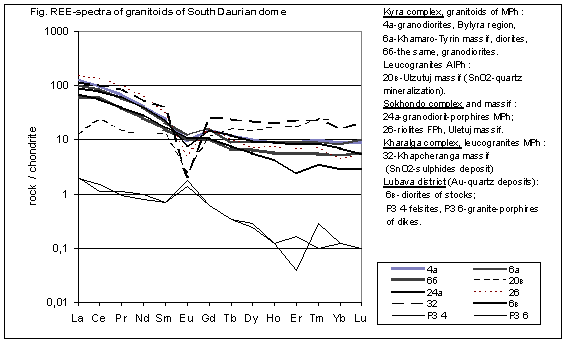|
PETROLOGICAL-GEOCHEMICAL AND METALLOGENIC DIVISION OF GRANITOIDS OF KHAPCHERANGA-LUBAVA ORE REGION, TRANSBAIKALIA
Kozlov V.D., Spiridonov A.M., Chokan V.M. Institute of Geochemistry SB RAS, Irkutsk Russia, kvd@igc.irk.ru
The Khapcheranga-Lubava ore region is characterized by an unusual for Transbaikalia (Smirnov, 1936) close spatial combination of veined gold-quartz (Lubava ore field) and tin-sulfide (Khapcheranga deposit) industrial mineralization. The main uniting magmatic formation in the region is the submeridional granodiorite Khamaro-Tyrin (Kh-T) massif (with its north Arytsyr satellite massif) of the Triassic Kyra complex, which intrudes the host schist rocks (T1). On the east margin of this massif these rocks contain Khapcheranga ore field, adjoining from the south to the Khapcheranga stock of leucogranites of the Kharalga (J2-3) ore-bearing complex of rare-metal leucogranite intrusions enriched by granitophile rare elements (B, F, Li, Rb, Cs, Be, Son, W, Mo, Ta, Pub, The, U). They are associated with tin-tungsten mineralization (Kozlov, Svadkovskaya, 1977). Ore veins of the group of the Lubava gold deposits are located in extensive (≈ 14 km) sublatitudinal tectonic zone (1, 5 km wide), transversal to the Khamaro-Tyrin massif and are hosted in the same schists T1 (Spiridonov et al., 2006). Within this zone the gold-quartz mineralization is associated with earlier sublatitudinal granodiorite stocks (Lubava, Khaverga etc.) and numerous extent sublatitudinal dyke series of sericite-replaced felsites and granite-porphyries and lesser abundant diorite porphyrites which cut stocks (Shubin, 1984). The initial magmatism in the Lubava zone includes small bodies of granodiorites, which are united with the Khamaro-Tyrin massif of the Kyra complex (Shubin, 1984; Geological map... 1997). However, dyke series of rocks uncommon to batholith massifs of the Kyra complex in viewpoints of some investigators are connected with subvolcanic granodiorite-granite Sokhondo complex (J2-3), located in the marginal part of the Daurian dome. The petrochemical comparison of the main phase granodiorites of Khamaro-Tyrin massif and Lubava stocks indicate their significant difference in distribution of alkalis. The main phase granodiorites of the Khamaro-Tyrin massif together with sparse granites of the final phase demonstrate near-Clarke concentrations of Na2O (3,6 – 4%) and К2О (2.8 – 4.5%) in the range of SiO2 concentrations from 63 to 74%. In the same range the Lubava granodoirites and granite-porphyries-felsites of dykes shows a stable decrease in K2O concentration to 2.2–3.5%, that is by 20-30% lower as compared with granodiorites of the Khamaro-Tyrin massif. A more significant difference of granitoids of these two sites is visible in concentrations of 11 granitophile elements. In the Khamaro-Tyrin granodiorites their total deficit as compared with the Clarke level in granites makes up −2.9 Clarke, while in the non-altered Lubava diorites and sericite-replaced granite-porphyries-felsites it increases in each rock type to −5.3 Clarke, showing a sharp depletion of Lubava granitoids by all granitophile elements. Moreover, the similarity in K2O deficit and significant deficit in granitophile elements in the Lubava granitoids can confirm their genetic similarity. The granitoids of all complexes of the region and the Lubava region most differ in distribution of rare-earth elements (REE), based on the comparison of REE spectra (Fig.) normalized from chondrite. The most compact REE spectra are common to MPh granitoids of the Kyra and Sokhondo complexes, including Khamaro-Tyrin massif (spectra 4a, 6a, 6б, 24a). The differentiates of these complexes i.e. leucogranites of AIPh (additional intrusive phase) (spectrum 20в) and rhyolites of final phase (PPh) (spectrum 26) are marked by Eu-minimum, owing to critical decrease in contents of Ca and in particular Sr and Ba which are closely related to bivalent Eu. The ore-bearing leucogranites of additional intrusive phase (AIPh) (20в) along with granitophile elements concentrate heavy lanthanoids (Sm-Lu, Y-group). Spectrum 32 of ore-bearing rare-metal granites of the Khapcheranga stock (Kharalga complex) demonstrates the highest concentrations of light and heavy lanthanoids and an evident Eu-minimum. On diagram granitoids of the Lubava region are subdivided into two groups. The spectrum of stock diorites (6в) even being close to the spectra of MPh granitoids of the Kyra and Sokhondo complexes, are significantly different by the decrease of heavy lanthanoid concentrations (Dy-Lu). Spectra of leucocratic felsites and granite-porphyries dykes are unusual: having anomalously low concentrations of light and heavy lanthanoids, correlating with sharply decreased concentrations of rare granitophile elements in dykes, they demonstrate heightened Eu and correspondingly Sr and Ba contents, that markedly differ them from leucocratic differentiates of granite intrusions both barren and ore-bearing rare-metal, which always show the decreased concentration of Eu, Sr, Ba. Thus, the magmatism of the Lubava gold region can not be regarded as belonging to one of the granitoid complexes available in the region. Thus, it is an independent granitoid complex and ore-magmatic system that conforms to conclusions by L. V. Tauson with his colleague (1973, in (Spiridonov et al., 2006, p. 116)).
References Geological Map of Chita Region, 1:500 000. Ed. By I.G. Rutshtein, N.N. Chaban, Chita: GGUP “Chita Geological Survey”, 1997. Smirnov S.S. Scheme of metallogeny of the East Transbaikalia// Problems of Soviet Geology, 1936, issue 6, N.10, P.846-864. Spiridonov A.M., Zorina L.D., Kitaev N.A. Gold-bearing ore-magmatic systems of Transbaikalia. Novosibirsk: Academic Publishing House “Geo”, 2006, 291p. Shubin G.V., Types of gold mineralization of the Daurian zone. Novosibirsk: Nauka, 1984, 209p.
|
